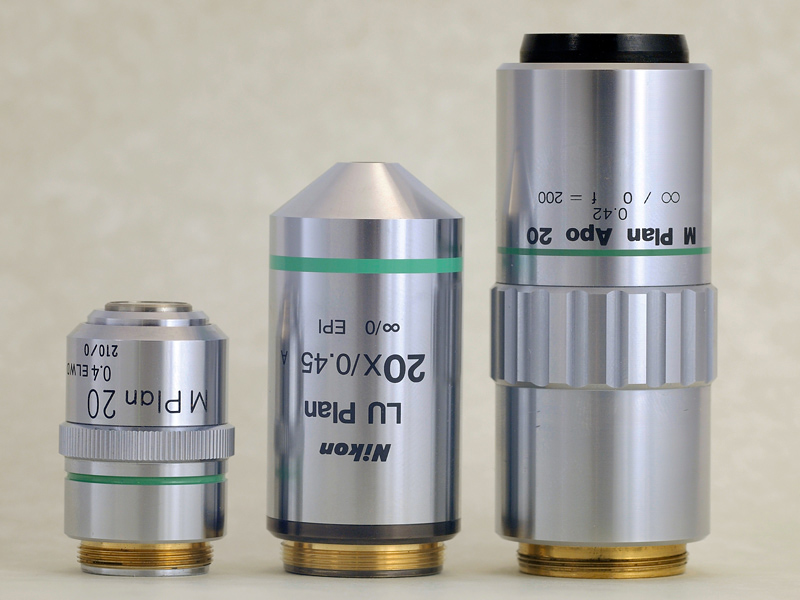
I just tested the three objectives pictured above (Nikon M Plan 20/0.4 ELWD, WD=10.5mm; Nikon LU Plan EPI 20X/0.45, WD=4.5mm; Mitutoyo M Plan Apo 20/0.42, WD=20mm) to determine their center and corner performance on my D300 (23.6 x 15.8mm sensor, 28.6mm diagonal).
The Mitutoyo and the Nikon LU infinity objectives were mounted approximately 75mm and 100mm from the edge of the front barrel of a 210mm f/6.1 Schneider Xenar lens, which had been focused to infinity. Using a stage micrometer and ImageJ, a free image analysis program, I found the magnification resulting from both combinations to be 21.65X ( I believe that the focal length of the Xenar is slightly greater than designated, since the Mitutoyo provides 24X magnification when used with a 240mm Apo-Ronar, as predicted). I matched the 21.65X magnification when I used the ELWD.
The wing was illuminated with a Vivitar 283 flash through three fiber optic light guides, the light slightly softened through a cylinder of Lee 250 ½ White Diffusion gel.
I took approximately 140 JPEG images at 2μm increments with each objective, and then stacked them with ZS PMax. The output images were then processed minimally in Photoshop (Levels adjustments and minor USM sharpening) before posting. The crops below are actual pixel size.

Olive Hairstreak, Mitoura grynea, Mitutoyo 20
Center Crops:

Mitutoyo

Nikon LU

Nikon ELWD
Corner Crops:

Mitutoyo

Nikon LU

Nikon ELWD
All three lenses performed fairly consistently across the image field at this magnification, with little apparent deterioration in quality from center to corner. The Mitutoyo seems to provide marginally better definition than the Nikon LU objective, and the Nikon ELWD objective is a little softer. On the other hand, it's a lot easier to use
For the next round of tests, I would like to see if reducing the distance between the front of the tube lens and the Mitutoyo objective mount has
any effect (Mitutoyo specifies 76.5mm for a 30mm image field, but as Charles Krebs points out in this thread here , they also state that "a smaller distance does not affect an optical performance".)
I would also like to see if there are any negative effects (on my sensor format) of using the intermediate lens focused at distances other than infinity.

